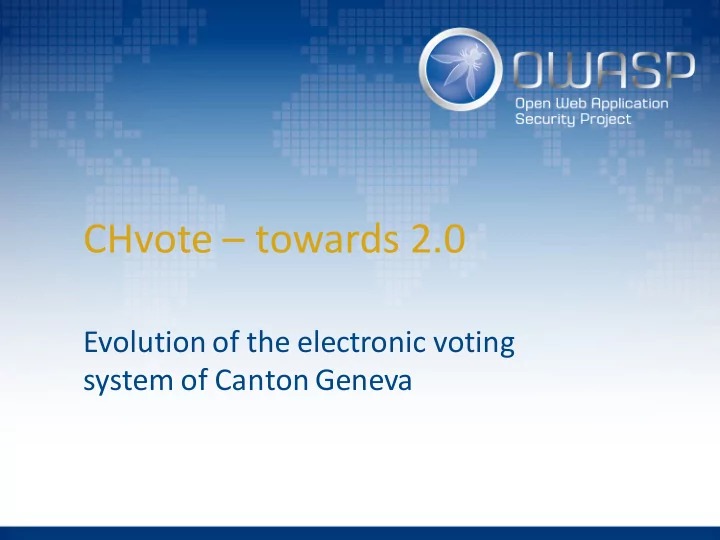

CHvote – towards 2.0 Evolution of the electronic voting system of Canton Geneva
Bio • Thomas Hofer • Java Dev • OWASP Geneva, co-chapter leader • State of Geneva • @thhofer / thomas.hofer@owasp.org
Outline • Context • Updated requirements • Core protocol concepts • Implementation overview • Current results • Ongoing work
Context • Stable democracy • 4 referendum & initiatives rounds / year • municipal, cantonal and federal elections – Usually 2-4 rounds / year • currently used by several cantons • Developed, hosted & maintained by Geneva
Preliminary project – Goals • New voting protocol (BFH) • PoC Implementation (State of Geneva) – Feasibility – Performance – Constraints and limitations • Publication of specification and code
Updated requirements > Intro • New ordinance on Electronic Voting (2013) – Technical & admin requirements • Compliance levels -> allowed percentage of electorate – 30% / 50% / 100% • https://www.bk.admin.ch/themen/pore/evoting/ 07979/index.html
Upd. Req. > Individual verifiability voters must receive proof that the server system has registered the vote as it was entered by the voter on the user platform – VEleS, art. 4 • In current version: random codes per voter / response
Upd. Req. > End-to-End encryption Votes must not be stored or transmitted in unencrypted form at any time from being entered to tallying. – Technical and administrative requirements, section 3.3.4 • In current version: – Incompatible with individual verifiability implementation – Server needs to know vote to return the matching verification code
Upd. Req. > Universal verifiability For universal verification, the auditors receive proof that the result has been ascertained correctly. They must evaluate the proof in a observable procedure. – VEleS, art. 5 paragraph 4 • In current version: – Not available; external supervision by party representatives holding the private decryption key
Upd. Req. > Control components The trustworthy part of the system includes either one or a small number of groups of independent components secured by special measures (control components). Their use must also make any abuse recognisable if per group only one of the control components works correctly and in particular is not manipulated unnoticed. – VEleS, art. 5, par. 6 • In current version: – Application server protected by organisational measures and enforced policies
Core protocol concepts • El Gamal homomorphic encryption • Oblivious Transfer for individual verifiability – Cast-as-Intended Verification in Electronic Elections Based on Oblivious Transfer • Pedersen Commitments • Non-interactive Zero-Knowledge Proofs • Wikström ’s Proof of a Shuffle
Homomorphic encryption • Allows re-encryptions – Useful for anonymizing when shuffling • Allows for key sharing – Control components each hold a key share
Oblivious Transfer • In short – Server knows n secret messages – Client allowed to retrieve k secret messages – Server cannot know which messages the client asked for – Perfect match for the verification codes issue! • In detail – Cast-as-Intended Verification in Electronic Elections Based on Oblivious Transfer
Commitments and ZKPs • “public” commitments for the secrets • ZKPs relative to those commitments – Chain of truth from key generation to ballot decryption • Combination yields Universal verifiability
Wikstr öm’s Proof of a Shuffle • Re-encrypting mix-net • Since shuffled, simple pre-image proofs would not work • Since re-encrypted, ciphertexts are not equal • Need for a specific profo that the cryptographic shuffle is valid
Implementation • Algorithms – ch.ge.ve.protopoc.service.algorithm • Utilities defined in specification – ch.ge.ve.protopoc.service.support • Simulation-related classes – ch.ge.ve.protopoc.service.simulation • Run simulation – ./gradlew simulation
Implementation – Snippet /** * Algorithm 7.4: GetNIZKPChallenge * * @param y the public values vector (domain unspecified) * @param t the commitments vector (domain unspecified) * @param kappa the soundness strength of the challenge * @return the computed challenge */ public BigInteger getNIZKPChallenge(Object[] y , Object[] t , int kappa ) { return conversion.toInteger( hash.recHash_L( y , t )).mod(BigIntegers. TWO .pow( kappa )); }
Implementation – Demo
Results: Specification • https://ia.cr/2017/325 • Written by team at BFH
Results: PoC implementation • Covers complete protocol (incl. proofs) • Available on GitHub – https://github.com/republique-et-canton-de- geneve/chvote-protocol-poc • Issues & PRs welcome!
Result: Performance estimates • Also available on GitHub – Much better than initially feared – 100k ballots could be • Shuffled, • Decrypted, • & Verified; • Using “standard” hardware • Within operational time constraints
Soooo … what’s left then? • GUI • Distribution – Real infrastructure for Control Components • Resilience • Custom rules for layout, specific elections, … • Back- office, test zone, … • Cantonal interoperability
Q&A
Recommend
More recommend